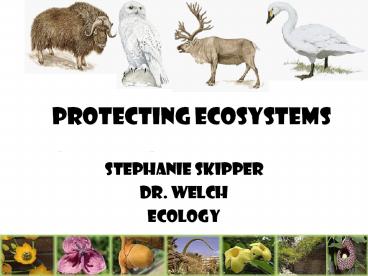Protecting Ecosystems - PowerPoint PPT Presentation
1 / 14
Title:
Protecting Ecosystems
Description:
Protecting Ecosystems Stephanie Skipper Dr. Welch ECOLOGY Protecting Ecosystems What is an ecosystem? Why should ecosystems be protected? What types of areas or ... – PowerPoint PPT presentation
Number of Views:148
Avg rating:3.0/5.0
Title: Protecting Ecosystems
1
Protecting Ecosystems
- Stephanie Skipper
- Dr. Welch
- ECOLOGY
2
Protecting Ecosystems
- What is an ecosystem?
- Why should ecosystems be protected?
- What types of areas or ecosystems are most
important to protect? - What are the factors that are considered in
selecting,designing,and managing reserves.
3
Ecosystems
4
What is an Ecosystem
- An ecosystem can be defined as an interacting
system of plants, animals, and humans and their
surrounding physical environment - Ecosystems can be defined by different scales or
sizes from as small a puddle or a rotting log to
a forest to the planet.
5
Why should ecosystems be protected?
- To preserve biodiversity
- People take different approaches when making the
case for preserving biodiversity. Some argue that
biodiversity is important to ensure access to new
medications, while others emphasize the
importance of maintaining healthy ecosystems for
recreational purposes such as fishing or camping.
- Ecosystems are the productive engines of the
planet, providing us with everything from the
water we drink to the food we eat and the fiber
we use for clothing, paper, and lumber
6
What types of areas or ecosystems are most
important to protect?
- Fresh water
- The world's Freshwater ecosystem provides most of
the world's water for drinking, agriculture,
sanitation, and industry, as well as huge
quantities of fish and shellfish. The Great
Lakes, located on the border between the United
States and Canada, contain 20 of all the fresh
surface water resources on Earth - Freshwaters are also home to a tremendous
diversity of fish, amphibians, aquatic plants,
invertebrates, and microorganisms. The Amazon
River alone contains an estimated 3000 species of
fish - The Freshwater ecosystem offers important
cultural, economic and recreational resources for
human populations around the world.
7
Threats to Freshwater Ecosystems
- Chemical pollution introduced into freshwater
systems through agricultural runoff, the over-use
of pesticides, herbicides, and fertilizers, the
improper disposal of waste and industrial
by-products. - Thermal pollution (the unnatural heating or
cooling of freshwater habitats), caused by the
release of heated water, used in industrial
processes, back into streams, rivers and lakes
the diversion of our waterways by means of
concrete embankments and dams built to create
manmade lakes. - Deforestation of the Earth's forests, which can
adversely affect both the sedimentation rate and
temperature of the Freshwater ecosystem. - The over-harvesting of fish and edible aquatic
species for man's consumption. - Acid rain, resulting from the huge amount of car
exhaust belched from the incredible number of
cars driven on a daily basis
8
Ways to help the freshwater ecosystems
- Never release into your local rivers, ponds, or
streams, non-native fish, frogs, turtles, or
salamanders, kept as pets, when you no longer
want them - Do not buy or use toxic pesticides or herbicides
for your lawns, gardens, or weed and pest
control. Read the labels! Make it your business
to know what you are using! Dispose of harmful
chemicals carefully. Do not just pour them out on
the ground or down the drain
9
Marine Ecosystems
- The ocean is home to the smallest plankton and
the largest creature on earth, the blue whale.
10
Marine Ecosystems
The diversity and productivity of marine
ecosystems are also important to human survival
and well-being. These habitats provide us with a
rich source of food and income, and support
species that serve as animal feed, fertilizers
for crops, additives in foods (i.e., ice-cream)
and cosmetics (i.e., creams and lotions). Areas
such as mangroves, reefs, and sea grass beds also
provide protection to coastlines by reducing wave
action, and helping to prevent erosion, while
areas such as salt marshes and estuaries have
acted as sediment sinks, filtering runoff from
the land. Despite the importance of marine
ecosystems, increased human activities such as
over fishing, coastal development, pollution, and
the introduction of exotic species have caused
significant damage and pose a serious threat to
marine biodiversity
11
(No Transcript)
12
Marine ecosystems
- Mangrove forest
- Salt marshes
- Mud Flats
13
What are the factors that are considered in
selecting and managing reserves
- Ecosystems have been destroyed so much were some
are very rare in certain parts of the countries - Some countries have made reserves and national
parks in order to preserve some of the world
precious ecosystems - When choosing the land and area to start a
reserve on, a number of factors are taken into
account
- Factors that determine reserves or national parks
- Designing a reserve
- Reserve selection
- Reserve management
14
Works cited
- Chapter 8 from Conservation Biology
- Chapter11 from Fundamentals of Conservation
Biology - http//www.epa.gov/bioindicators/aquatic/marine.ht
ml - www.askjeeves.com
- www.dogpile.com































